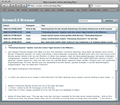Screen2.0
news // 2008.11.27 08:07:01 [hh]
DxO Labs bieten High-End-Kameradatenbank
Der französische Digitalphoto-Software-Spezialist DxO Labs hat jetzt als Zweitverwertung seiner ganzen Meßaktivitäten für seinen Raw-Converter "DxO Optics Pro" in Form einer Kamera-Datenbank zusammengefaßt. Das Ergebnis ist die Site "DxOMark".
DxO Labs über seinen neuen Service:
"dxomark.com (beta version) is a new website featuring the first database of objective digital camera image quality measurements entirely accessible via the internet. In addition to the Image Quality Database itself, dxomark.com proposes a new scale, the DxOMark Sensor scale, that enables to rank digital camera with a single number: an easy tool for photographers to evaluate and compare models. Four principal characteristics make the DxOMark Sensor scale and the Image Quality (IQ) Database uniquely valuable to members of the photographic community who are passionate about image quality:
RAW sensor-based
All published measurements are RAW sensor-based and performed prior to any digital image processing (camera- or PC software-based). As RAW format is considered the equivalent of a film negative by analogy to traditional photography, it is the format by which camera body performance is most effectively evaluated, as it does not depend on the camera optics nor on the quality of the RAW conversion applied.
Reproducible
All measurements are objective, conforming on the one hand to ISO standards (ISO), and on the other hand to accepted scientific methodology, thanks to DxO Analyzer. As the only solution on the market that takes measurements directly from RAW images using automated processing to ensure fully-reproducible results, DxO Analyzer is the tool of reference for the imaging industry and photography reviewers.
DxO Labs, the creator of DxO Analyzer, is the world leader in image quality measuring tools. In addition to serving as technical editor for the Camera Phone Image Quality (CPIQ) Initiative Group of the International Imaging Industry Association (I3A), with which it also participates in defining the standards for cameraphone image quality, DxO Labs also contributes solutions to such difficult technological challenges as finding ways to scientifically measure perceived image quality attributes such as preservation of texture and color richness.
Normalized data
The DxOMark Sensor scale results and the IQ Database measurements are painstakingly and exhaustively obtained across the entire range of sensor functioning parameters, describing the performance of the camera body for all its functional modes, white balance, and ISO settings. These measurements are furnished both as raw data, but also as normalized data so as to permit fair comparison between camera bodies with different resolutions, number or size of pixels, and/or sensitivity.
The DxOMark Sensor scale
The IQ Database could not be used easily without a global scale of measuring, evaluating, and comparing camera body quality. This is why DxO Labs has also invented the DxOMark Sensor scale, which aggregates the measurements of the IQ Database in a simple and logical manner.
One of the innovations of DxOMark Sensor scale is that it was conceived and built on three principal photographic uses:
- studio and portrait photography
- landscape photography
- photojournalism and sports photography
Thanks to DxO Labs Image Quality Database and the DxOMark Sensor scale, photographers no longer have to rely solely on manufacturers’ published data to evaluate digital camera image quality."
"There are many valuable resources reviewing the image quality of digital cameras, but none of them consider the actual RAW signal straight from the camera sensor", so Nicolas Touchard, Vice President of Marketing, DxO Labs Image Quality Evaluation business. "Demanding photographers who shoot in RAW should only care about the genuine quality of the RAW image, yet until now they have had to rely on measures based on converted RAW images, obviously biased by the processing applied to them, whether embedded or performed offline with a software RAW converter."
Weitere Informationen: www.dxomark.com
Werbung












